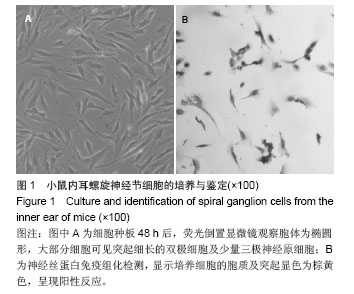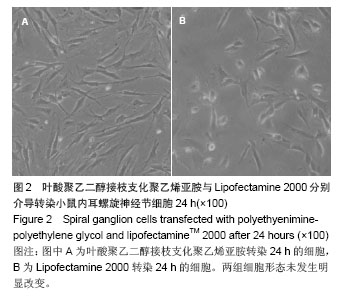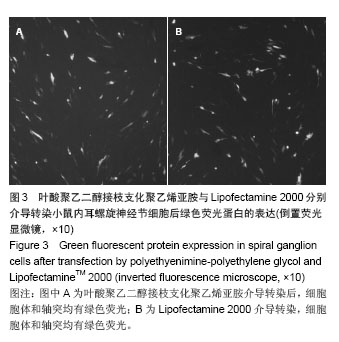| [1]Chen Y,Yang L,Huang S,et al.Delivery system for DNAzymes using arginine-modified hydroxyapatite nanoparticles for therapeutic application in a nasopharyngeal carcinoma model. Int J Nanomedicine.2013;8:3107-3118.
[2]Sun NF,Liu ZA,Huang WB,et al.The research of nanoparticles as gene vector for tumor gene therapy.Crit Rev Oncol Hematol. 2014;89(3):352-357.
[3]Boussif O,Lezoualc'h F,Zanta MA,et al.A versatile vector for gene and oligonucleotide transfer into cells in culture and in vivo: polyethylenimine. Proc Natl Acad Sci U S A. 1995;92(16): 7297-7301.
[4]Choosakoonkriang S,Lobo BA,Koe GS,et al.Biophysical characterization of PEI/DNA complexes.J Pharm Sci. 2003; 92(8):1710-1722.
[5]张璇,潘仕荣,冯敏,等. PEG-PEI共聚物介导VEGF165基因转染及对内皮细胞生长的影响[J]. 生物化学与生物物理进展, 2007, 34(10):1065-1071.
[6]Liu Y,Liu Z,Wang Y,et al.Investigation of the performance of PEG-PEI/ROCK-II-siRNA complexes for Alzheimer's disease in vitro.Brain Res.2013;1490:43-51.
[7]Liu C,Liu F,Feng L,et al.The targeted co-delivery of DNA and doxorubicin to tumor cells via multifunctional PEI-PEG based nanoparticles.Biomaterials.2013;34(10):2547-2564.
[8]Liang B,He ML,Xiao ZP,et al.Synthesis and characterization of folate-PEG-grafted-hyperbranched-PEI for tumor-targeted gene delivery.Biochem Biophys Res Commun. 2008;367(4): 874-880.
[9]Merkel OM,Beyerle A,Librizzi D,et al.Nonviral siRNA delivery to the lung: investigation of PEG-PEI polyplexes and their in vivo performance.Mol Pharm.2009;6(4):1246-1260.
[10]段亚君,杨翠红,张振方,等.非病毒基因载体介导短发夹RNA转染抑制肿瘤细胞生长[J].科学通报,2009,54(9):1193-1197.
[11]Fu Y,Ding D,Wei L,et al.Ouabain-induced apoptosis in cochlear hair cells and spiral ganglion neurons in vitro. Biomed Res Int.2013;2013: 628064.
[12]Yumusakhuylu AC,Yazici M,Sari M,et al.Protective role of resveratrol against cisplatin induced ototoxicity in guinea pigs.Int J Pediatr Otorhinolaryngol.2012; 76(3):404-408.
[13]蒋明,张永全,贺广湘,等.羟基磷灰石纳米颗粒介导NT-3基因对豚鼠兴奋毒性损伤耳蜗的保护作用[J].中南大学学报:医学版, 2007,32(4):563-567.
[14]陈观贵,谢鼎华,刘谦虚,等.脑源性神经营养因子基因修饰的骨髓间充质干细胞在药物致聋豚鼠内耳的表达及保护作用[J].中华耳鼻咽喉头颈外科杂志,2010,45(11):924-929.
[15]Levine RM,Pearce TR,Adil M,et al.Preparation and characterization of liposome-encapsulated plasmid DNA for gene delivery.Langmuir.2013;29(29):9208-9215.
[16]Samadikhah HR,Majidi A,Nikkhah M,et al.Preparation, characterization, and efficient transfection of cationic liposomes and nanomagnetic cationic liposomes. Int J Nanomedicine.2011;6:2275-2283.
[17]Elangovan S,Jain S,Tsai PC,et al.Nano-sized calcium phosphate particles for periodontal gene therapy.J Periodontol. 2013;84(1):117-125.
[18]Zhang W,Zhang Y,Lobler M,et al.Nuclear entry of hyperbranched polylysine nanoparticles into cochlear cells.Int J Nanomedicine.2011;6:535-546.
[19]Pyykko I,Zou J,Zhang W,et al.Nanoparticle-based delivery for the treatment of inner ear disorders.Curr Opin Otolaryngol Head Neck Surg.2011;19(5):388-396.
[20]Husseman J, Raphael Y.Gene therapy in the inner ear using adenovirus vectors. Adv Otorhinolaryngol.2009;66:37-51.
[21]蒋明,张永全,贺广湘,等.阳离子脂质体介导小鼠原代螺旋神经节细胞NT-3基因转染的实验研究[J].中国耳鼻咽喉颅底外科杂志, 2006,12(1):10-13.
[22]陈请国,褚汉启,王显红,等.新生大鼠螺旋神经节细胞体外生长特点及脂质体介导的转染效率[J].听力学及言语疾病杂志, 2010, 18(5):462-465.
[23]周艳芳,陈晓爱,叶美红,等.正交设计优化聚乙烯亚胺介导肝癌细胞基因转染效率的研究[J].生物医学工程学杂志, 2011,28(1): 104-109.
[24]陈磊,田华雨,陈学思,等.交联型聚乙烯亚胺智能基因载体的制备及PEG化影响[J].高分子学报,2009,53(6):499-505.
[25]Liu W,Kinnefors A,Bostrom M,et al.Expression of TrkB and BDNF in human cochlea-an immunohistochemical study. Cell Tissue Res.2011;345(2):213-321. |


